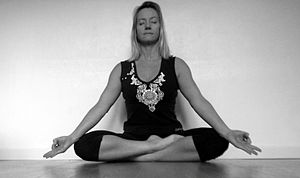Note: This is a project under development. The articles on this wiki are just being initiated and broadly incomplete. You can Help creating new pages.
Difference between revisions of "Siddhasana"
Chaithrika (talk | contribs) (Created page with "thumb|right|''Siddhasana'' The name comes from the Sanskrit words siddha (सिद्ध; siddha) meaning both "perfect" and "adept", and asana (आ...") |
(No difference)
|
Revision as of 17:20, 30 November 2016
The name comes from the Sanskrit words siddha (सिद्ध; siddha) meaning both "perfect" and "adept", and asana (आसन; āsana) meaning "posture" or "seat".
From a seated position, one heel is brought to press on the perineum with the sole of the foot flat against the inner thigh. The body sits on top of this heel. Adjustments are made until the body is comfortable and the pressure is firmly applied. Then the opposite ankle is placed over the first, so the ankle bones are touching and the heels are above one another with the top heel pressing the pubis directly above the genitals. The genitals will then lie in between the two heels. The toes and outer edge of the top foot are pushed down into the space between the calf and thigh muscles. The toes of the bottom foot are pulled up into the similar space on the opposite side. The spine is held erect. A small meditation cushion or zafu is sometimes used to aid vertical back alignment.
The Accomplished Pose for women or Siddha Yoni Asana is the same, except the bottom heel is placed firmly against or inside the labia majora of the vagina and the top heel is placed so it presses the clitoris.
Use
Siddhasana and Padmasana (Lotus Pose) are the two asanas traditionally used for dhyana (meditation) and pranayama (breath) exercises. Sukhasana (Pleasant Pose) is a substitute that is easier on the knees. Many people are not able to practice Padmasana due to the inflexibility long-term chair sitting has caused in their hips. This is common in Western culture. For them Siddhasana is highly recommended.
